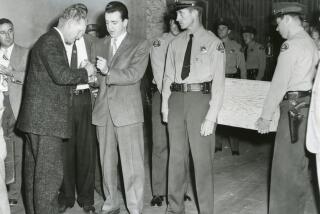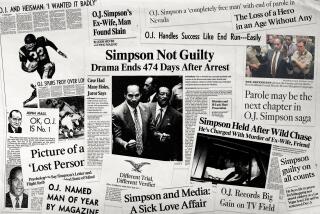Anger Rises Over Killer’s Parole Effort
- Share via
The day Edgar Smith is released from prison, Ray Ozbun plans to move his family away from San Diego, keep the location a secret and obtain an unlisted telephone number.
“If I stayed here, I’d never be able to leave the house without worrying,” said Ozbun, whose wife was abducted and almost killed by Smith in 1976. “I wouldn’t be able to concentrate at work. I’d always feel uneasy. I’d always be aware that Smith knew where my wife was.”
Lefteriya Ozbun said she is angry that Smith is eligible for parole, because, “He can get out of prison in a few years, but I have to live with what he did to me forever. . . . He changed my life.”
Hours of Surgery
After Smith attacked her with a knife, which pierced her liver and diaphragm, she underwent several hours of surgery. Her hospital stay of more than two weeks included three days in the intensive-care unit. When she was released, the police asked her to attend a lineup and identify Smith. She stood behind the glass partition, watching the suspects, prepared to check off a printed form with a pencil. When she spotted him, she was so shaken that she snapped the pencil in two.
Though Ozbun’s chest was still painful from the surgery and she was still frightened, she returned to work as a seamstress at the Ratner Corp. clothing plant six weeks after the attack. The bills had mounted, she said, and her family needed the money.
For the next few years, everyday incidents frequently reminded her of the attack. She would take her dog for a walk, see a car pull over and run back inside the house. She would walk into a restaurant, see a man wearing a white T-shirt--as Smith had been--and become paralyzed with fear. She would lose sight of her small son and begin screaming. She would walk by the parking lot at work where she was abducted and her heart would pound.
Ozbun eventually had to quit her job because passing the lot was too painful. She now works in the alteration department of a San Diego department store.
“Maybe it’s been so frightening because of how it happened,” said Ozbun, who was 33 at the time of the attack. “It wasn’t because I was careless, or out at 2 or 3 in the morning. I was just walking in the afternoon by the parking lot where I work every day. I was minding my own business . . . “
A Miracle She Lived
Ozbun paused in mid-sentence, shrugged and stared out the window of her cluttered San Diego home, oblivious for a moment to the cacophony of four dogs, a blaring television and an 8-year-old son. Then, she looked up and said softly: “You know, everybody is still frightened for me. But lately, I haven’t had the fear.” She smiled faintly. “It just disappeared one day.”
It is a miracle, Ozbun said, that she is even alive today. And she is proud, she said, of the way she fought to survive.
“You know, I bet he never, in his wildest dreams, expected me to come out of that alive.”
Ozbun was attacked as she walked to the parking lot after work to meet her husband. She was intercepted by Smith, who put a knife to her throat and forced her into his car.
Smith had intended to kill Ozbun and even had the location picked out, said Paige Hiemier, Smith’s ex-wife. After the crime, when Smith was in jail, Hiemier said, he told her about his plans to kill Ozbun and how they went awry.
Smith never reached the spot where he wanted to kill Ozbun because she put up such a struggle. She kicked out the windshield of his car and, with a 6-inch knife sticking out of her side, grappled with him for the steering wheel and forced the car onto a freeway exit.
Ozbun recalled lying on the side of the road, the knife still in her and blood dripping from her mouth, afraid that she was dying but willing herself to live because she knew her husband and children needed her.
Though many familiar with Smith’s case have argued that he should have been executed while he was on Death Row in New Jersey, Ozbun disagreed. She does not believe in the death penalty.
“Society shouldn’t act the same way as the killers,” she said. “We need to keep them isolated in prison--some, like Smith, until they die. But to kill these people makes us no better than them.”
During the years after the attack, Ozbun often wondered why Smith singled her out and why he attempted to kill her. She eventually tracked down a few of Smith’s books and read them, searching for insight into his personality.
“He’d spent so many years on Death Row fighting for his freedom,” Ozbun said. “I just wanted to know why, after finally winning this freedom and getting that second chance he wanted so much, did he jeopardize it again? I never found the answer.”
More to Read
Sign up for Essential California
The most important California stories and recommendations in your inbox every morning.
You may occasionally receive promotional content from the Los Angeles Times.










